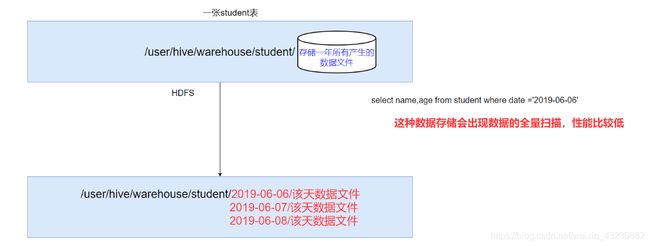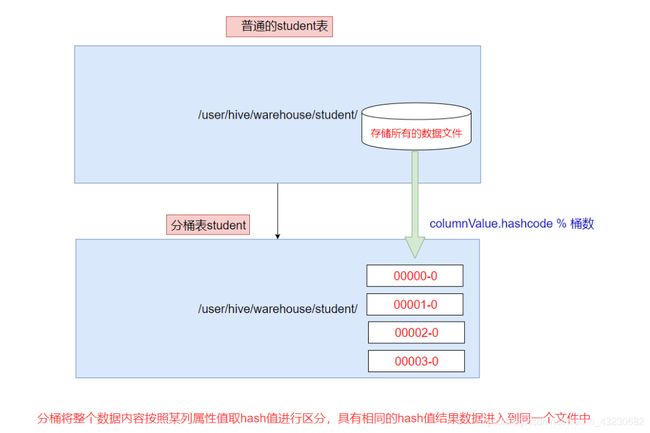Hive中的数据导入和导出、分区表和分桶表的使用与区别详解
目录
一、Hive数据导入
二、Hive数据导出
三、Hive的分区表
1.1 为什么要分区?
1.2 外部分区表综合练习
四、Hive的分桶表
1.1 分桶表原理
1.2 作用
1.3 案例演示:创建分桶表
五、分区表和分桶表的区别
一、Hive数据导入
1 直接向表中插入数据(强烈不推荐使用)
hive (myhive)> create table score3 like score;
hive (myhive)> insert into table score3 partition(month ='201807') values ('001','002','100');2 通过load加载数据(必须掌握)
-
语法:
hive> load data [local] inpath 'dataPath' [overwrite] into table student [partition (partcol1=val1,…)]; -
通过load方式加载数据
hive (myhive)> load data local inpath '/xsluo/install/hivedatas/score.csv' overwrite into table score partition(month='201806');3 通过查询加载数据(必须掌握)
-
通过查询方式加载数据
-
语法;官网地址
INSERT OVERWRITE TABLE tablename1 [PARTITION (partcol1=val1, partcol2=val2 ...) [IF NOT EXISTS]] select_statement1 FROM from_statement;
INSERT INTO TABLE tablename1 [PARTITION (partcol1=val1, partcol2=val2 ...)] select_statement1 FROM from_statement;-
例子
hive (myhive)> create table score5 like score;
hive (myhive)> insert overwrite table score5 partition(month = '201806') select s_id,c_id,s_score from score;4 查询语句中创建表并加载数据(as select)
-
将查询的结果保存到一张表当中去
hive (myhive)> create table score6 as select * from score;5 创建表时指定location
-
创建表,并指定在hdfs上的位置
hive (myhive)> create external table score7 (s_id string,c_id string,s_score int) row format delimited fields terminated by '\t' location '/myscore7';-
上传数据到hdfs上,我们也可以直接在hive客户端下面通过dfs命令来进行操作hdfs的数据
hive (myhive)> dfs -mkdir -p /myscore7;
hive (myhive)> dfs -put /xsluo/install/hivedatas/score.csv /myscore7;-
查询数据
hive (myhive)> select * from score7;6 export导出与import 导入 hive表数据(内部表操作)
hive (myhive)> create table teacher2 like teacher;
-- 导出到hdfs路径
hive (myhive)> export table teacher to '/xsluo/teacher';
hive (myhive)> import table teacher2 from '/xsluo/teacher';二、Hive数据导出
1 insert 导出
-
表 -> 文件
-
官方文档
-
语法
INSERT OVERWRITE [LOCAL] DIRECTORY directory1
[ROW FORMAT row_format] [STORED AS file_format] (Note: Only available starting with Hive 0.11.0)
SELECT ... FROM ...-
将查询的结果导出到本地
insert overwrite local directory '/xsluo/install/hivedatas/stu' select * from stu;-
将查询的结果格式化导出到本地
insert overwrite local directory '/xsluo/install/hivedatas/stu2' row format delimited fields terminated by ',' select * from stu;-
将查询的结果导出到HDFS上==(没有local)==
insert overwrite directory '/xsluo/hivedatas/stu' row format delimited fields terminated by ',' select * from stu;2 Hive Shell 命令导出
-
基本语法:
-
hive -e "sql语句" > file
-
hive -f sql文件 > file
-
在linux命令行中,运行如下命令;导出myhive.stu表的数据到本地磁盘文件/xsluo/install/hivedatas/student1.txt
-
hive -e 'select * from myhive.stu;' > /xsluo/install/hivedatas/student1.txt3 export导出到HDFS上
export table myhive.stu to '/xsluo/install/hivedatas/stuexport';三、Hive的分区表
1.1 为什么要分区?
如果hive当中所有的数据都存入到一个文件夹下面,那么在使用MR计算程序的时候,读取一整个目录下面的所有文件来进行计算,就会变得特别慢,因为数据量太大了
实际工作当中一般都是计算前一天的数据,所以我们只需要将前一天的数据挑出来放到一个文件夹下面即可,专门去计算前一天的数据。
这样就可以使用hive当中的分区表,通过分文件夹的形式,将每一天的数据都分成为一个文件夹,然后我们计算数据的时候,通过指定前一天的文件夹即可只计算前一天的数据。
在大数据中,最常用的一种思想就是分治,我们可以把大的文件切割划分成一个个的小的文件,这样每次操作一个小的文件就会很容易了,同样的道理,在hive当中也是支持这种思想的,就是我们可以把大的数据,按照每天,或者每小时进行切分成一个个的小的文件,这样去操作小的文件就会容易得多了
在文件系统上建立文件夹,把表的数据放在不同文件夹下面,加快查询速度。
创建分区表语法:
hive (myhive)> create table score(s_id string, c_id string, s_score int) partitioned by (month string) row format delimited fields terminated by '\t';创建一个表带多个分区
hive (myhive)> create table score2 (s_id string,c_id string, s_score int) partitioned by (year string, month string, day string) row format delimited fields terminated by '\t';加载数据到分区表当中去
hive (myhive)>load data local inpath '/xsluo/install/hivedatas/score.csv' into table score partition (month='201806');加载数据到多分区表当中去
hive (myhive)> load data local inpath '/xsluo/install/hivedatas/score.csv' into table score2 partition(year='2018', month='06', day='01');查看分区
hive (myhive)> show partitions score;添加一个分区
hive (myhive)> alter table score add partition(month='201805');同时添加多个分区
hive (myhive)> alter table score add partition(month='201804') partition(month = '201803');注意:添加分区之后就可以在hdfs文件系统当中看到表下面多了一个文件夹
删除分区
hive (myhive)> alter table score drop partition(month = '201806');1.2 外部分区表综合练习
需求描述:
- 现在有一个文件score.csv文件,里面有三个字段,分别是s_id string, c_id string, s_score int
- 字段都是使用 \t进行分割
- 存放在集群的这个目录下/scoredatas/day=20200808,这个文件每天都会生成,存放到对应的日期文件夹下面去
- 文件别人也需要公用,不能移动
- 请创建hive对应的表,并将数据加载到表中,进行数据统计分析,且删除表之后,数据不能删除
需求实现:
数据准备:
node03执行以下命令,将数据上传到hdfs上面去
将我们的score.csv上传到node03服务器的/xsluo/install/hivedatas目录下,然后将score.csv文件上传到HDFS的/scoredatas/day=20200808目录下
cd /xsluo/install/hivedatas/
hdfs dfs -mkdir -p /scoredatas/day=20200808
hdfs dfs -put score.csv /scoredatas/day=20200808/1)创建外部分区表,并指定文件数据存放目录
hive (myhive)> create external table scoredatas(s_id string, c_id string, s_score int)
> partitioned by (day string)
> row format delimited
> fields terminated by '\t'
> location '/scoredatas';2)导入数据到hive表
进行表的修复,说白了就是建立我们表与我们数据文件之间的一个关系映射。
此处,scoredatas表已经是一个外部表,而且已经指向了 hdfs 的 /scoredatas 目录,而要将 /scoredatas 下的数据导入 scoredatas 表,其实就是将 /scoredatas 下的一个 天目录 映射到 scoredatas 表的一个 天分区 ,以下三种方式都可以:
方式一:msck repair table scoredatas;
方式二:load data inpath '/scoredatas/day=20200808' into table scoredatas partition(day='20200808');
方式三:alter table scoredatas add partition(day='20200808') location '/scoredatas/day=20200808';
三种方式效率上都差不多,其中load导入数据的方式最为常用,这里用msck方式演示一下:
hive (myhive)> msck repair table scoredatas;四、Hive的分桶表
如下图所示:
1.1 分桶表原理
分桶是相对分区进行更细粒度的划分
-
Hive表或分区表可进一步的分桶
-
分桶将整个数据内容按照某列取hash值,对桶的个数取模的方式决定该条记录存放在哪个桶当中;具有相同hash值的数据进入到同一个文件中
-
比如按照name属性分为3个桶,就是对name属性值的hash值对3取摸,按照取模结果对数据分桶。
-
取模结果为==0==的数据记录存放到一个文件
-
取模结果为==1==的数据记录存放到一个文件
-
取模结果为==2==的数据记录存放到一个文件
-
1.2 作用
-
取样sampling更高效。没有分桶的话需要扫描整个数据集。
-
提升某些查询操作效率,例如map side join
1.3 案例演示:创建分桶表
在创建分桶表之前要执行的命令
-
set hive.enforce.bucketing=true; 开启对分桶表的支持
-
set mapreduce.job.reduces=4; 设置与桶相同的reduce个数(默认只有一个reduce)
进入hive客户端然后执行以下命令:
use myhive;
set hive.enforce.bucketing=true;
set mapreduce.job.reduces=4;
-- 创建分桶表
create table myhive.user_buckets_demo(id int, name string)
clustered by(id)
into 4 buckets
row format delimited fields terminated by '\t';
-- 创建普通表
create table user_demo(id int, name string)
row format delimited fields terminated by '\t';准备数据文件 buckets.txt
#在linux当中执行以下命令
cd /xsluo/install/hivedatas/
vim user_bucket.txt
1 anzhulababy1
2 anzhulababy2
3 anzhulababy3
4 anzhulababy4
5 anzhulababy5
6 anzhulababy6
7 anzhulababy7
8 anzhulababy8
9 anzhulababy9
10 anzhulababy10加载数据到普通表 user_demo 中
load data local inpath '/xsluo/install/hivedatas/user_bucket.txt' overwrite into table user_demo;加载数据到桶表user_buckets_demo中
insert into table user_buckets_demo select * from user_demo;hdfs上查看表的数据目录
抽样查询桶表的数据
-
官网地址
-
tablesample抽样语句语法:tablesample(bucket x out of y)
-
x表示从第几个桶开始做数据采样
-
y与进行采样的桶数的个数、每个采样桶的采样比例有关;
-
select * from user_buckets_demo ;
需要采样的总桶数 = 分桶数/y = 结果ret
分两种情况
情况一:ret>1
需要采样的总桶数 = 分桶数/y = 4/2 = 2个
即从2个桶进行数据的采样
x = 1 先从第1个桶中取出数据
x+y = 1+2 = 3 再从第3个桶中取出数据
情况二:ret<1
假设还是此表user_buckets_demo,分桶数是4
x=1
y=8
∴需要采样的总桶数 = 分桶数/y = 4/8 = 0.5
ret<1,只能从1个桶进行数据的采样
x = 1 从第1个桶中取出0.5一半的数据五、分区表和分桶表的区别
Hive中的分区表是通过分文件夹的形式,把表的数据按照某个维度进行分目录存储在不同的分区(文件夹)下面,后期按照不同的目录查询数据,不需要进行全量扫描,提升查询效率,如下图所示:
而Hive中的分桶表则是相对分区进行更细粒度的划分,Hive表或分区表都可作进一步的分桶。分桶其实就是将整个Hive表或者分区表中的数据通过分文件的形式将数据存储在不同的桶(文件)下面,原理是按照某列取hash值,然后再通过对桶的个数取模来决定该条数据存放在哪个桶(文件)当中。对于一些大的(分区)表,没有分桶的话需要扫描整个数据集,就会变得特别慢,因为数据量太大了。在分桶之后就可以进一步提升某些查询操作效率,而且取样sampling也更高效,如下图所示:





